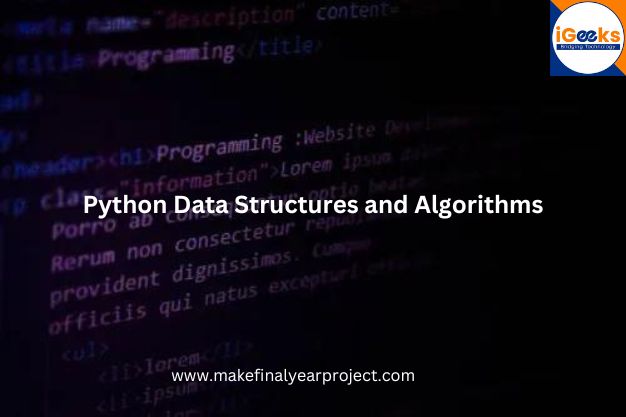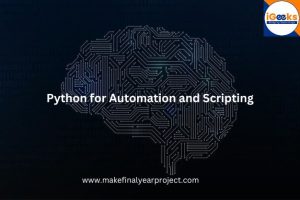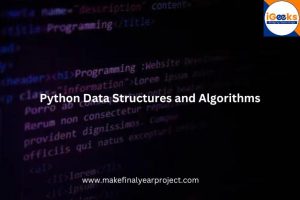By iGeeks Technologies:
Unlock the power of deep learning with these hands-on Python projects. At iGeeks Technologies, we believe in the transformative potential of deep learning, and these projects are designed to give you practical experience in implementing cutting-edge solutions. Explore the intersection of Python programming and deep learning algorithms with these engaging projects.
Python Data Structures and Algorithms
Data structures and algorithms are foundational concepts in computer science, essential for organizing and manipulating data efficiently. Python, with its rich set of built-in data structures and libraries, provides powerful tools for implementing various algorithms and solving complex problems. Understanding Python data structures and algorithms is key to writing efficient and scalable code, enabling developers to tackle a wide range of computational tasks effectively.
In Python, data structures serve as containers for holding and organizing data in a specific layout. Built-in data structures such as lists, tuples, dictionaries, and sets offer different functionalities and trade-offs, catering to diverse programming needs. Mastery of these data structures allows developers to choose the most appropriate one for each scenario, optimizing performance and resource usage.
Introduction to Data Structures
Data structures are containers that store and organize data for efficient access and manipulation. In Python, built-in data structures such as lists, tuples, dictionaries, and sets provide versatile options for managing collections of elements. Lists are ordered collections that support dynamic resizing and allow for efficient element access and modification. Tuples are immutable sequences often used to represent fixed collections of values. Dictionaries are key-value pairs that enable fast lookup and retrieval based on unique keys. Sets are unordered collections of unique elements that support set operations such as union, intersection, and difference.
Understanding the properties and behaviors of these data structures is essential for writing Python code that is both efficient and maintainable. By leveraging the appropriate data structure for a given task, developers can optimize memory usage, improve runtime performance, and streamline their code. Moreover, familiarity with common data structure operations such as insertion, deletion, traversal, and search is crucial for implementing algorithms and solving computational problems effectively.
Common Data Structure Operations
Python data structures support various operations that enable efficient manipulation of data. Lists, for example, offer methods for adding and removing elements, accessing elements by index, and performing operations such as sorting and reversing. Similarly, dictionaries provide functions for adding and removing key-value pairs, accessing values by key, and iterating over items. Understanding how to perform these operations effectively is essential for writing Python code that is both efficient and maintainable.
Moreover, Python’s built-in data structures are versatile and can be combined and nested to create more complex data structures to suit specific needs. For instance, lists of dictionaries or sets of tuples can be used to represent more structured data models. By mastering the operations supported by Python’s built-in data structures, developers gain the flexibility and expressiveness needed to tackle a wide range of programming tasks, from simple data processing to complex algorithmic problem-solving.
Algorithms and Algorithm Analysis
Algorithms are step-by-step procedures or methods for solving computational problems. Python provides implementations of many classic algorithms, including sorting algorithms like quicksort and mergesort, searching algorithms like binary search, and graph algorithms like breadth-first search and depth-first search. Understanding algorithm analysis, which involves evaluating the efficiency and performance of algorithms in terms of time complexity and space complexity, is crucial for selecting the most appropriate algorithm for a given problem and optimizing overall system performance.
Python’s extensive standard library and ecosystem of third-party packages provide developers with access to a wealth of algorithms and data structures for solving various computational problems. Whether it’s numerical computing with NumPy, data manipulation with pandas, or machine learning with scikit-learn, Python offers powerful tools for tackling a wide range of tasks. By leveraging these libraries and understanding the underlying algorithms and data structures, developers can write more efficient and maintainable code and build robust solutions for real-world problems.
Conclusion
Python data structures and algorithms are fundamental concepts that form the backbone of computer science and programming. By mastering these concepts, developers can write code that is both efficient and scalable, enabling them to tackle complex computational tasks with confidence. With Python’s rich set of built-in data structures, versatile libraries, and extensive ecosystem, developers have access to powerful tools for solving a wide range of problems across various domains.
Whether it’s manipulating lists, dictionaries, and sets, implementing classic algorithms, or leveraging advanced data structures and libraries, Python provides the flexibility and expressiveness needed to address diverse programming challenges. By understanding the principles of data structures and algorithms and applying them effectively in Python, developers can unlock new possibilities, streamline their code, and build innovative solutions that push the boundaries of what’s possible in software development.











